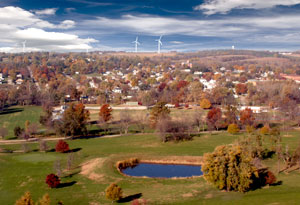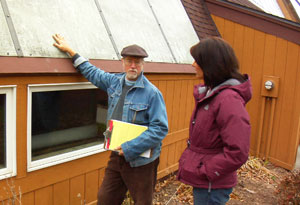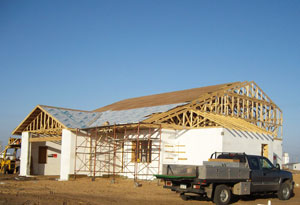The Greening of Small-Town America

Across the Midwest, small towns are going through green revolutions. They're using wind and solar power and green construction to help their communities survive and thrive.
Rock Port, MissouriAbove the outskirts of a small farming community in northwest Missouri are four massive structures fitted with large blades that cut through the air like the propellers of an airplane. They're wind turbines, and they're capable of providing 100 percent of Rock Port's electricity needs.
"It goes to show what a little can-do attitude can do," says Eric Chamberlain, a Rock Port businessman. In November 2006, Chamberlain decided to investigate the possibility of building a wind farm near his hometown of 1,400 after seeing large energy-producing wind turbines in nearby Iowa. "[Wind power] is environmentally benign, extremely clean and a natural resource. I had no concept at the time about the economics of a wind farm; I had just enough information to be dangerous," Chamberlain says.
Just a few months after Chamberlain began researching the wind speeds in his community, John Deere and Wind Capital Group signed on finance a small wind farm and make his idea a reality.
Rock Port photographer W.C. Farmer documented the construction and completion of the four steel wind turbines and says the project was truly and example of how one person can help change a community for the better. "It's people like Eric Chamberlain, who didn't worry about who took credit for the idea; he just wanted to see it happen. I believe that is the embodiment of the American spirit," Farmer says.
Chamberlain says he just asked the right people the right questions at the right time. His persistence paid off—Chamberlain says the turbines now save the town $50,000 a year in electricity transmission fees and has changed the way people in Rock Port think about energy consumption. "It did draw a lot of attention to the way we use energy, and it also drew attention to the fact that that small communities can take on big tasks and projects and succeed."
Inside Solar Town USA

Photo: Solar Town USA
Soldiers Grove, Wisconsin
In the late '70s—before it was in vogue to be green—Soldiers Grove, Wisconsin, became America's first solar village. It was a move the town of 600 made after much of the community was destroyed in July 1978 by massive flooding of the nearby Kickapoo River. "The flooding is what started the process of relocating to higher ground and constructing businesses with solar panels," says Tamera Kelper, Soldiers Grove's clerk and treasurer.
The townspeople rebuilt their community further away from the river and constructed many new buildings with solar panels. The grocery store, beauty shop, fire station and a dozen other businesses installed solar panel systems that now supply 50 percent of the town's heating needs, Kelper says.
Now, more 30 years after the town installed its first solar panel, filmmaker Brain Kosisky decided to feature Soldiers Grove in his documentary Solar Town USA . "It is an inspiring story of how the residents took something negative—severe flooding—and made something positive out of it: rebuilding their town from scratch and creating America's very first solar town," Kosisky says.
The documentary, hosted and co-produced by former CNN anchor Daryn Kagan, features the ups and downs the community went through while switching to solar and what it's like to maintain solar technology for three decades. "They are optimistic yet down-to-earth," Kosisky says. "While they are all proud of their town and the sustainable solar elements, they admit that some of the systems are no longer working at peak performance. Right now, the state of Wisconsin is studying the buildings to see how the systems can be improved."
While it is uncertain what the future holds for Soldiers Grove and its green initiatives, Kosisky says the town is "the quintessential example of optimism in the face of adversity."
The ultimate green town: Greensburg, Kansas
In the late '70s—before it was in vogue to be green—Soldiers Grove, Wisconsin, became America's first solar village. It was a move the town of 600 made after much of the community was destroyed in July 1978 by massive flooding of the nearby Kickapoo River. "The flooding is what started the process of relocating to higher ground and constructing businesses with solar panels," says Tamera Kelper, Soldiers Grove's clerk and treasurer.
The townspeople rebuilt their community further away from the river and constructed many new buildings with solar panels. The grocery store, beauty shop, fire station and a dozen other businesses installed solar panel systems that now supply 50 percent of the town's heating needs, Kelper says.
Now, more 30 years after the town installed its first solar panel, filmmaker Brain Kosisky decided to feature Soldiers Grove in his documentary Solar Town USA . "It is an inspiring story of how the residents took something negative—severe flooding—and made something positive out of it: rebuilding their town from scratch and creating America's very first solar town," Kosisky says.
The documentary, hosted and co-produced by former CNN anchor Daryn Kagan, features the ups and downs the community went through while switching to solar and what it's like to maintain solar technology for three decades. "They are optimistic yet down-to-earth," Kosisky says. "While they are all proud of their town and the sustainable solar elements, they admit that some of the systems are no longer working at peak performance. Right now, the state of Wisconsin is studying the buildings to see how the systems can be improved."
While it is uncertain what the future holds for Soldiers Grove and its green initiatives, Kosisky says the town is "the quintessential example of optimism in the face of adversity."
The ultimate green town: Greensburg, Kansas

Photo: Solar Town USA
Greensburg, Kansas
Much like the story of Soldiers Grove, a natural disaster almost wiped Greensburg, Kansas, off the map in May 2007. An EF5 tornado tore through the town of 1,500, leveling most of its homes and buildings and killing 11 people. Just days after the tragedy, the people of Greensburg vowed to rebuild their community and make it what they call a sustainable "GreenTown".
"It has been amazing to watch what is possible in coming through a tragedy when there is hope to give the adversity meaning, like rebuilding as a model [community] for the world," says Daniel Wallach, the executive director of Greensburg GreenTown, a nonprofit organization working to rebuild the town. "Creating beauty out of chaos is art and can be enormously rewarding. I think many residents feel this."
Using some of the knowledge gained from Soldiers Grove's venture into solar power after a natural disaster and Rock Port's commitment to producing wind energy, Greensburg is hoping to create a community that is sustainable now and for future generations. "Why build buildings that have short life spans, cause problems because of poor indoor air quality or cost a bundle to heat and cool? Rural folks have a strong tendency toward common sense, and when you look at all the angles, building green is plain common sense," Wallach says.
Kosisky also featured Greensburg in Solar Town USA . He says there are many lessons from Soldiers Grove that Greensburg can incorporate into its rebuilding efforts."Keep it simple, plan for the systems' upkeep, allow upgrading to be affordable and educate the citizens on the best use of the new systems," Kosisky says.
Wallach says Greensburg is taking advice from Soldiers Grove to heart. The town is not only educating its citizens about sustainable building—it's hoping to teach the rest of the world as well. "The town is now an eco-educational tourist destination, which will likely be a significant economic engine in the new Greensburg," he says. "The American spirit is about ingenuity, resourcefulness and caring. This is a huge part of the culture in Greensburg, and it is something our country needs at this time more than ever."
Much like the story of Soldiers Grove, a natural disaster almost wiped Greensburg, Kansas, off the map in May 2007. An EF5 tornado tore through the town of 1,500, leveling most of its homes and buildings and killing 11 people. Just days after the tragedy, the people of Greensburg vowed to rebuild their community and make it what they call a sustainable "GreenTown".
"It has been amazing to watch what is possible in coming through a tragedy when there is hope to give the adversity meaning, like rebuilding as a model [community] for the world," says Daniel Wallach, the executive director of Greensburg GreenTown, a nonprofit organization working to rebuild the town. "Creating beauty out of chaos is art and can be enormously rewarding. I think many residents feel this."
Using some of the knowledge gained from Soldiers Grove's venture into solar power after a natural disaster and Rock Port's commitment to producing wind energy, Greensburg is hoping to create a community that is sustainable now and for future generations. "Why build buildings that have short life spans, cause problems because of poor indoor air quality or cost a bundle to heat and cool? Rural folks have a strong tendency toward common sense, and when you look at all the angles, building green is plain common sense," Wallach says.
Kosisky also featured Greensburg in Solar Town USA . He says there are many lessons from Soldiers Grove that Greensburg can incorporate into its rebuilding efforts."Keep it simple, plan for the systems' upkeep, allow upgrading to be affordable and educate the citizens on the best use of the new systems," Kosisky says.
Wallach says Greensburg is taking advice from Soldiers Grove to heart. The town is not only educating its citizens about sustainable building—it's hoping to teach the rest of the world as well. "The town is now an eco-educational tourist destination, which will likely be a significant economic engine in the new Greensburg," he says. "The American spirit is about ingenuity, resourcefulness and caring. This is a huge part of the culture in Greensburg, and it is something our country needs at this time more than ever."
More Green Ideas






